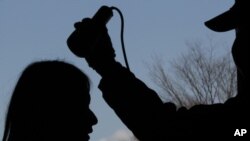Officials say highly radioactive plutonium has been detected in the soil in five locations around Japan's earthquake-disabled nuclear reactor, adding to the problems faced by workers struggling to get the power plant under control.
The Tokyo Electric Power Company, TEPCO, that runs the Fukushima plant said late Monday it believed some of the plutonium came from nuclear fuel in the damaged reactors. But the company insisted the levels were not high enough to be considered a risk to human health.
The US embassy in Tokyo said the chief of the Nuclear Regulatory Commission, Gregory Jaczko, was on his way to Japan Monday to assess the current situation. Jaczko said the NRC was ready to provide any assistance it can to ease the nuclear crisis.
The International Atomic Energy Agency said Monday the situation at the nuclear station is still very serious.
Chief Cabinet Secretary Yukio Edano said earlier Monday he suspected a partial meltdown of one of the Fukushima earthquake-disabled nuclear reactors was leading to pools of highly radioactive water that plant operators say have been found in trenches outside the plant's buildings.
Plant workers are caught between trying to pump uncontaminated water into the reactors to cool them so that they can fix the damage inside, and getting rid of the radioactive water.
Edano said the government's top priority was to prevent the contaminated water from seeping into the ground water system. He urged residents to stay away from the 20-kilometer evacuation zone as the area continued to be very risky.
Greenpeace called on the government to extend the evacuation zone, as their experts have found unsafe radiation levels 40 kilometers northwest of the plant.
Radioactive contamination has been spreading into the seawater and soil for the past two weeks, since the reactors' cooling systems were seriously damaged in the March 11 earthquake and tsunami.
The contaminated water appears to be leaking from the one of the damaged plant's reactors after having been in contact with melted-down fuel rods inside the reactor's core. The discovery is the latest setback for crews that have been battling fires, explosions and spikes in radioactivity in their efforts to repair the cooling systems.
More than 10,800 people have been confirmed dead since the quake and 16,200 are missing, according to national NHK television. It said 193,000 people are living in evacuation centers, down from about 300,000 last week.
TEPCO officials said Monday radiation levels in the leaked water were "extremely high". Company officials said they were continuing to monitor seawater for radioactivity, and that it would have to develop a plan to monitor radiation levels underground.
Edano said the water seems to be coming from inside the plant's pressure chamber where it has been exposed to melted-down fuel rods in the reactor's core. That would confirm suspicions that the reactor suffered at least a partial meltdown, and that water is escaping from the pressure chamber.
The power company said Monday that water found in a utility trench outside the number two reactor building was emitting radiation at a rate of more than 1,000 millisieverts per hour. Officials said that is about the same level as the water inside the building, which was reported Sunday to be 100,000 times higher than normal.
Two workers were taken to a hospital last week after suffering burns to their feet while wading in the radioactive water. Officials said Monday the workers were recuperating.
Radiation from the plant, which lost its cooling systems during the March 11 earthquake and tsunami, has also been detected in milk and vegetables in a wide area around the plant and in tap water as far away as Tokyo, 220 kilometers to the south.
Related video by Melinda Smith:
Some information for this report was provided by AP, AFP and Reuters.

















